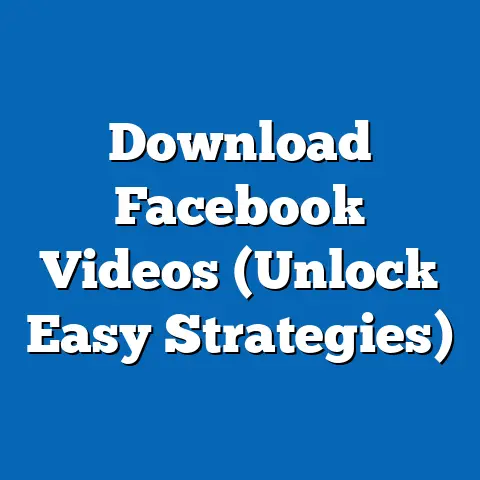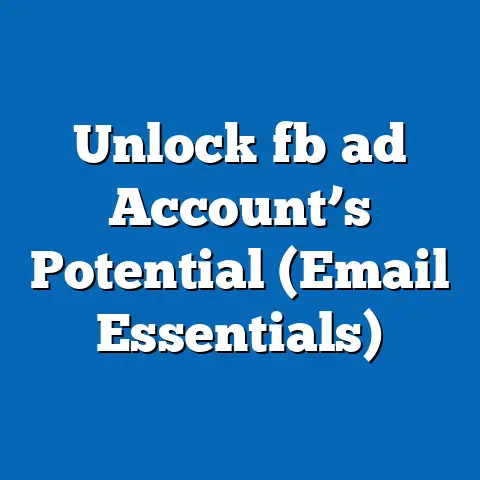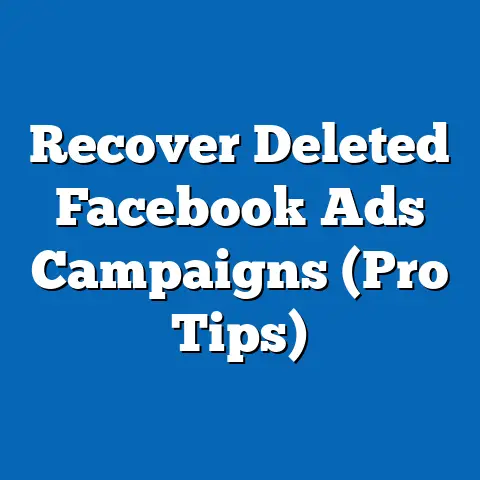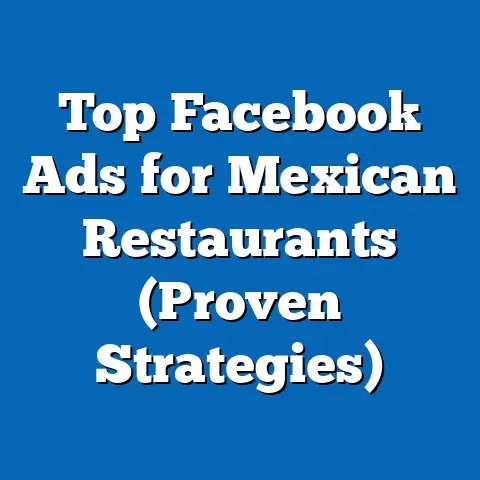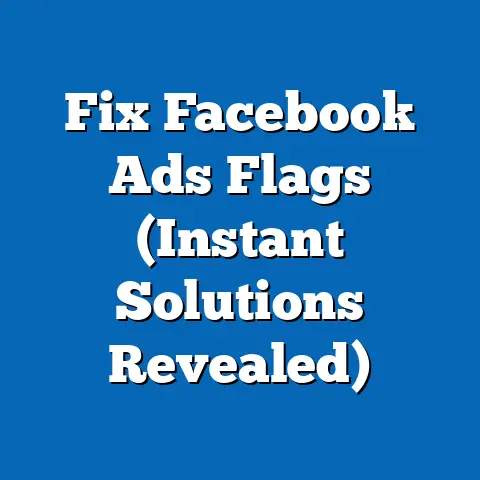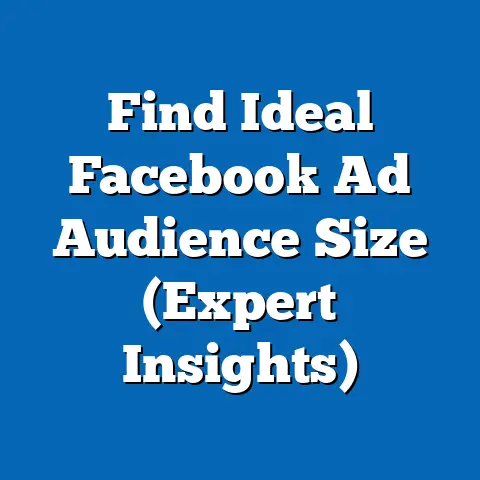Boost Engagement with Facebook Video Feed Ads (Pro Tips)
In today’s fast-paced digital world, standing still is the same as falling behind. That’s especially true when it comes to social media marketing. What worked last year, or even last month, might be completely ineffective now. This constant evolution demands a proactive approach – a strategy that anticipates change and adapts accordingly. That’s where the concept of “future-proofing” comes in. It’s about building a marketing strategy that’s not just effective today, but also resilient and adaptable to the inevitable shifts in technology, user behavior, and platform algorithms.
Facebook, with its ever-changing landscape, is a prime example of a platform that demands future-proofed strategies. And one area that’s consistently proving to be a powerhouse for engagement is video content. As users increasingly consume information through short, engaging videos, mastering Facebook Video Feed Ads becomes essential.
I’ve seen firsthand how businesses that embrace video and adapt their strategies see significantly better results. I remember working with a small e-commerce business struggling to get traction. They were relying solely on static image ads, and their engagement was dismal. After a few weeks of experimenting with video feed ads, their engagement skyrocketed. They saw a 3x increase in click-through rates and a significant boost in sales. It was a game-changer for them, and it highlighted the power of video when used strategically.
This article is your guide to navigating the world of Facebook Video Feed Ads. I’ll show you how to not only create engaging video content but also how to future-proof your approach so you can stay ahead of the curve and achieve your marketing goals. So, let’s dive in and explore how to effectively use Facebook Video Feed Ads to boost engagement and ensure your strategy remains relevant for years to come.
Understanding Facebook Video Feed Ads
Facebook Video Feed Ads are exactly what they sound like: video ads that appear directly within a user’s Facebook news feed. Unlike static image ads, these ads leverage the power of motion and sound to capture attention and convey information in a more dynamic and engaging way.
These ads seamlessly integrate into the user’s browsing experience, making them less intrusive than other ad formats. They can be used to tell a story, showcase a product, or simply grab attention with eye-catching visuals.
What sets Video Feed Ads apart from other Facebook ad formats is their ability to deliver a richer, more immersive experience. Think about it: a short, well-crafted video can convey far more information and emotion than a static image ever could. This makes them incredibly effective for brand storytelling, product demonstrations, and building deeper connections with your audience.
According to recent statistics, video ads generate significantly more engagement than static image ads on Facebook. Studies have shown that video ads have a higher click-through rate (CTR) and a longer dwell time compared to image ads. This means that users are not only more likely to click on video ads, but they also spend more time watching them, increasing the chances of brand recall and conversion.
For example, Dollar Shave Club famously used a humorous and engaging video ad to launch their brand. The video went viral, generating millions of views and significantly boosting their brand awareness and customer acquisition. This is a prime example of how a well-executed video ad can have a massive impact.
Key Takeaway: Facebook Video Feed Ads offer a powerful way to connect with your audience through engaging video content. They stand out from other ad formats due to their ability to deliver a richer, more immersive experience, leading to higher engagement and better results.
The Importance of Engagement
In the realm of Facebook advertising, engagement is king. It’s the lifeblood of successful campaigns, driving everything from ad performance to brand awareness and ultimately, conversion rates. But what exactly do I mean by “engagement”?
Engagement refers to the level of interaction users have with your ad. This includes likes, comments, shares, saves, and of course, video views. A high engagement rate signals to Facebook that your ad is relevant and interesting to your target audience. This, in turn, can lead to several benefits:
- Improved Ad Performance: Facebook’s algorithm favors ads that generate high engagement. When your ad is engaging, Facebook is more likely to show it to a wider audience, resulting in more impressions, clicks, and conversions.
- Increased Brand Awareness: Engaging ads are more likely to be shared and discussed, leading to increased brand visibility and awareness. This can help you reach new audiences and build a stronger brand presence.
- Higher Conversion Rates: When users are engaged with your ad, they’re more likely to click through to your website or landing page and take the desired action, whether it’s making a purchase, signing up for a newsletter, or downloading a resource.
- Reduced Ad Costs: The more engaging your ad is, the lower your cost per engagement (CPE) is likely to be. This means you can achieve better results with a smaller budget.
Facebook’s algorithm plays a crucial role in determining which ads are shown to users. The algorithm prioritizes content that is deemed relevant and engaging, based on factors like user behavior, ad performance, and engagement rates. Therefore, creating engaging video ads is not just about capturing attention; it’s about optimizing your ad for the algorithm to maximize its reach and impact.
I’ve noticed that ads with genuine, authentic content tend to perform better in terms of engagement. People are drawn to stories and experiences they can relate to. Avoid overly polished or sales-y videos and focus on creating content that feels natural and resonates with your audience.
Key Takeaway: Engagement is a critical factor in Facebook advertising success. Higher engagement rates lead to improved ad performance, increased brand awareness, higher conversion rates, and reduced ad costs. Understanding how Facebook’s algorithm works and creating engaging video content are essential for maximizing your ad’s reach and impact.
Pro Tips for Boosting Engagement with Video Feed Ads
Now that we understand the importance of engagement and how Facebook Video Feed Ads work, let’s dive into some actionable pro tips for boosting engagement and future-proofing your strategy:
Tip 1: Create Compelling Visuals
In the world of video advertising, visuals are everything. Your video needs to grab attention within the first few seconds, or you risk losing your audience. That’s why creating compelling visuals is paramount.
High-quality visuals and storytelling are key ingredients for success. Think about it: people are bombarded with content every day. To stand out, your video needs to be visually appealing and tell a story that resonates with your audience.
Here are some things to consider when creating your video visuals:
- Video Length: While there’s no magic number, shorter videos tend to perform better on Facebook. Aim for videos that are between 15 and 60 seconds long. This ensures that you capture attention quickly and keep viewers engaged without losing their interest. I have seen videos that are even shorter, about 6-10 seconds, perform well if they are highly engaging.
- Resolution: Use high-resolution video to ensure that your visuals are crisp and clear. Facebook recommends a resolution of at least 1080p (1920×1080 pixels). Pixelated or blurry videos can be a major turn-off and can negatively impact your ad performance.
- Aspect Ratio: Optimize your video for mobile viewing by using a vertical aspect ratio (9:16) or a square aspect ratio (1:1). These formats take up more screen space on mobile devices, making them more visually appealing and engaging.
- Visual Storytelling: Don’t just show your product; tell a story. Use visuals to create an emotional connection with your audience and convey the value of your product or service. Consider using customer testimonials, behind-the-scenes footage, or animated explainers to tell your story in a compelling way.
I’ve found that using vibrant colors and dynamic visuals can significantly improve engagement. Think about adding motion graphics, animations, or special effects to make your video more visually appealing.
Actionable Next Step: Review your existing video ads and assess the quality of your visuals. Are they high-resolution? Are they visually appealing? Do they tell a compelling story? If not, consider revamping your visuals to create a more engaging experience for your audience.
Tip 2: Optimize for Mobile Viewing
With the vast majority of Facebook users accessing the platform on their mobile devices, optimizing your video ads for mobile viewing is no longer optional – it’s essential.
Here’s why mobile optimization is so important:
- Mobile-First Mindset: People use their mobile devices differently than they use their computers. They’re often on the go, scrolling through their feeds quickly, and easily distracted. Your video needs to grab their attention within seconds.
- Sound Off: Many people watch videos on their mobile devices with the sound off. This means your video needs to be visually engaging enough to capture their attention even without audio.
- Screen Size: Mobile screens are smaller than computer screens, so your video needs to be optimized for smaller displays. This means using clear visuals, large text, and a vertical or square aspect ratio.
Here are some tips for optimizing your video ads for mobile viewing:
- Use Captions: Add captions to your video so that people can understand the message even with the sound off. Facebook offers an auto-captioning tool that can help you generate captions quickly and easily.
- Use Text Overlays: Use text overlays to highlight key points and reinforce your message. Keep the text concise and easy to read.
- Focus on Visuals: Make sure your visuals are clear, crisp, and engaging. Use high-resolution video and avoid using small text or cluttered graphics.
- Use a Vertical or Square Aspect Ratio: These formats take up more screen space on mobile devices, making them more visually appealing and engaging.
I’ve found that using a mobile-first approach when creating video ads can significantly improve engagement. This means thinking about how your video will look and perform on a mobile device from the very beginning of the creative process.
Actionable Next Step: View your existing video ads on your mobile device. How do they look? Are they easy to understand with the sound off? Are they visually appealing? If not, consider making adjustments to optimize them for mobile viewing.
Tip 3: Leverage Targeting Options
Facebook’s advanced targeting options are one of its greatest strengths. By leveraging these options, you can ensure that your video ads are shown to the right people, increasing the chances of engagement and conversion.
Facebook offers a wide range of targeting options, including:
- Demographics: Target users based on age, gender, location, education, and other demographic factors.
- Interests: Target users based on their interests, hobbies, and activities.
- Behaviors: Target users based on their online behavior, such as their purchase history, website visits, and app usage.
- Custom Audiences: Create custom audiences based on your existing customer data, such as email lists or website visitors.
- Lookalike Audiences: Create lookalike audiences based on your custom audiences. This allows you to reach new users who are similar to your existing customers.
Here are some tips for leveraging Facebook’s targeting options:
- Define Your Target Audience: Before you start creating your ad, take the time to define your target audience. Who are you trying to reach? What are their interests? What are their needs?
- Experiment with Different Targeting Options: Don’t be afraid to experiment with different targeting options to see what works best for your business.
- Use Custom Audiences: Custom audiences are a powerful way to reach your existing customers and website visitors.
- Use Lookalike Audiences: Lookalike audiences can help you reach new users who are similar to your existing customers.
I’ve found that creating highly targeted ads can significantly improve engagement and conversion rates. The more relevant your ad is to your audience, the more likely they are to engage with it.
Actionable Next Step: Review your existing ad campaigns and assess your targeting options. Are you targeting the right people? Are you using custom and lookalike audiences? If not, consider refining your targeting to reach a more relevant audience.
Tip 4: Utilize Captions and Text Overlays
As I mentioned earlier, many people watch videos on their mobile devices with the sound off. This means that your video needs to be visually engaging and easy to understand even without audio. That’s where captions and text overlays come in.
Captions provide a written transcript of the audio in your video, allowing viewers to understand the message even if they can’t hear the sound. Text overlays can be used to highlight key points, reinforce your message, and provide additional context.
Here are some tips for utilizing captions and text overlays:
- Use Captions for All Your Videos: Make it a standard practice to add captions to all your video ads. This ensures that your message is accessible to everyone, regardless of whether they can hear the sound.
- Keep Captions Concise and Easy to Read: Use clear, concise language in your captions and make sure they are easy to read on a small screen.
- Use Text Overlays Sparingly: Don’t clutter your video with too much text. Use text overlays to highlight key points and reinforce your message.
- Use Visual Hierarchy: Use different font sizes, colors, and styles to create a visual hierarchy and guide the viewer’s eye.
I’ve seen firsthand how adding captions and text overlays can significantly improve engagement. It makes your video more accessible and easier to understand, even for viewers who are watching with the sound off.
Actionable Next Step: Review your existing video ads and make sure they all have captions. Experiment with using text overlays to highlight key points and reinforce your message.
Tip 5: Incorporate Strong Calls-to-Action (CTAs)
A strong call-to-action (CTA) is essential for driving user action after they’ve watched your video. Your CTA should tell viewers exactly what you want them to do next, whether it’s visiting your website, making a purchase, or signing up for a newsletter.
Here are some tips for incorporating strong CTAs:
- Make Your CTA Clear and Concise: Use clear, concise language that tells viewers exactly what you want them to do.
- Use Action Verbs: Use action verbs like “Shop Now,” “Learn More,” or “Sign Up” to encourage viewers to take action.
- Make Your CTA Visually Appealing: Use a visually appealing button or graphic to draw attention to your CTA.
- Place Your CTA Strategically: Place your CTA at the end of your video or as a text overlay throughout the video.
I’ve found that using a sense of urgency in your CTA can significantly improve conversion rates. For example, you could use phrases like “Limited Time Offer” or “Shop Now While Supplies Last” to encourage viewers to take action immediately.
Actionable Next Step: Review your existing video ads and assess the strength of your CTAs. Are they clear, concise, and visually appealing? Do they create a sense of urgency? If not, consider revamping your CTAs to drive more user action.
Tip 6: Test and Iterate
In the ever-evolving world of Facebook advertising, testing and iteration are essential for long-term success. What works today might not work tomorrow, so it’s important to continuously test different video formats, lengths, and messaging to discover what resonates best with your audience.
A/B testing, also known as split testing, is a powerful technique for comparing two versions of your video ad to see which one performs better. You can test different headlines, visuals, CTAs, or targeting options to identify the winning combination.
Here are some tips for testing and iterating:
- Test One Variable at a Time: When A/B testing, it’s important to test only one variable at a time. This allows you to isolate the impact of that variable and determine whether it’s having a positive or negative effect on your ad performance.
- Use a Large Sample Size: To get statistically significant results, it’s important to use a large sample size when A/B testing. This means running your test for a sufficient amount of time and showing your ads to a large enough audience.
- Analyze Your Results: Once you’ve completed your A/B test, analyze the results to determine which version of your ad performed better. Use this information to inform your future ad campaigns.
I’ve found that A/B testing is an invaluable tool for optimizing my video ads. It allows me to make data-driven decisions and continuously improve my ad performance.
Actionable Next Step: Start A/B testing your video ads today. Experiment with different headlines, visuals, CTAs, and targeting options to discover what resonates best with your audience.
Tip 7: Analyze and Adapt
The final piece of the puzzle is to analyze your video performance metrics and make data-driven decisions for future campaigns. Facebook Insights provides a wealth of data about your video ads, including:
- Video Views: How many people have watched your video?
- View Duration: How long are people watching your video?
- Engagement Rate: How many people are liking, commenting, and sharing your video?
- Click-Through Rate (CTR): How many people are clicking on your CTA?
- Conversion Rate: How many people are taking the desired action after watching your video?
By analyzing these metrics, you can gain valuable insights into what’s working and what’s not. You can then use this information to adapt your future campaigns and improve your overall performance.
Here are some tips for analyzing and adapting:
- Track Your Key Metrics: Identify the key metrics that are most important to your business and track them regularly.
- Look for Trends: Look for trends in your data to identify patterns and opportunities.
- Experiment with Different Strategies: Don’t be afraid to experiment with different strategies to see what works best for your business.
- Stay Up-to-Date: Stay up-to-date on the latest Facebook advertising trends and best practices.
I’ve found that continuously analyzing my video performance metrics and adapting my campaigns accordingly is essential for long-term success. The Facebook advertising landscape is constantly changing, so it’s important to stay agile and adapt to new trends and best practices.
Actionable Next Step: Start tracking your video performance metrics today. Analyze your data to identify trends and opportunities, and use this information to adapt your future campaigns.
Case Studies and Success Stories
Let’s take a look at a few real-world examples of brands that have successfully implemented Video Feed Ads to boost engagement:
- Nike: Nike is a master of brand storytelling. They use video ads to showcase their athletes, inspire their audience, and promote their products in a visually stunning way. Their video ads are often highly engaging, generating millions of views and shares.
- Dove: Dove is known for their empowering and body-positive messaging. They use video ads to challenge beauty standards and promote self-esteem. Their video ads are often highly emotional and resonate deeply with their target audience.
- GoPro: GoPro uses video ads to showcase the amazing things their cameras can capture. Their video ads are often filled with breathtaking footage of extreme sports and outdoor adventures.
These are just a few examples of brands that have successfully used Video Feed Ads to boost engagement. By following the pro tips I’ve outlined in this article, you can also achieve similar results.
Conclusion
In conclusion, mastering Facebook Video Feed Ads is crucial for future-proofing your advertising strategy and boosting engagement. By creating compelling visuals, optimizing for mobile viewing, leveraging targeting options, utilizing captions and text overlays, incorporating strong CTAs, testing and iterating, and analyzing and adapting, you can create video ads that resonate with your audience and drive meaningful results.
Remember, the key to success is to stay agile, experiment with different strategies, and continuously adapt to the ever-changing landscape of Facebook advertising. Embrace video content, and you’ll be well on your way to achieving your marketing goals.
Don’t be afraid to experiment, take risks, and push the boundaries of what’s possible. The world of Facebook advertising is constantly evolving, and the only way to stay ahead of the curve is to be proactive and embrace change. So, go out there, create some amazing video ads, and watch your engagement soar!

